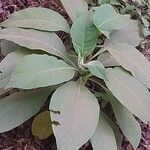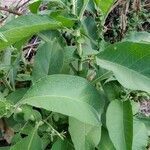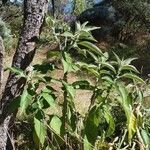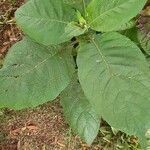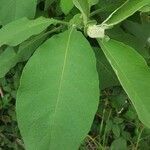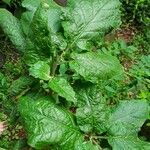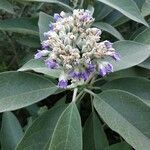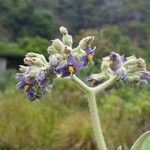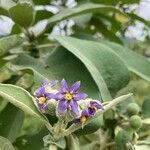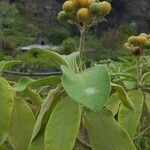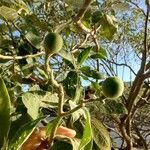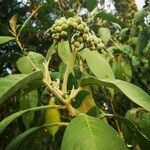Spreading, unarmed shrub or small tree to 10 m tall and with trunk to 15 cm diam., with all parts stellate-tomentose, the hairs ± sessile to long-stalked. lvs on vegetative and most flowering shoots with prominent stipule-like auricles 5-25 mm long at base; petioles to 6 cm long on flowering shoots, longer on strong vegetative shoots. Lamina 10-25-(40) × 3.5-10-(20) cm, ovate to elliptic, entire, light to dark green on upper surface, white to yellowish green on lower surface; base cuneate; apex usually acuminate but blunt at tip. Panicles dense, many-flowered, corymbose, terminal at first; rachis to 18 cm long, stout; pedicels ± erect at fruiting. Calyx c. 5 mm long, not accrescent; lobes ± elliptic. Corolla 1.5-2 cm diam., usually mauve to purple, occasionally white; lobes ovate or triangular-ovate, stellate-tomentose outside. Anthers 2-3 mm long. Berry c. 1 cm diam., globose, dull yellow; stone cells 0. Seeds 1-2 mm long, oblong-obovoid to suborbicular.
Shrub or small tree to 4 m high, green or grey-green, densely pubescent with stellate hairs; hairs loose and tufted on young growth, sparse on upper leaf-surface, dense on lower surface; prickles absent. Leaves elliptic; lamina 9–30 cm long, 3.5–14 cm wide, slightly discolorous, entire to slightly undulate; petiole 3–9 cm long, with 1–2 small sessile leaves in axil except on smaller twigs. Inflorescence branched, many-flowered; peduncle 3–15 cm long to first fork; pedicels 2–3 mm long. Calyx 4–6 mm long; lobes triangular, 1.5–3 mm long, slightly enlarged in fruit. Corolla stellate, 15–25 mm diam., violet. Anthers 2–3 mm long. Berry globular, 10–15 mm diam., dull yellow, pubescent, becoming glabrous with age. Seeds 1.5–2 mm long, light brown or yellowish.
Shrub, small tree, up to 5 m high; vegetative parts and calyces densely whitish, felty hairy. Stems later ± glabrous, striate. Leaves ovate to elliptical, up to 250 x 100 mm, unequal base decurrent on petiole, green velvety stellate-hairy above; petioles ± 40 mm long; stipules ovate, 20 x 15 mm, discolorous. Inflorescence dense; peduncles up to 100 mm long. Calyx 7 mm long, lobes ± triangular. Corolla ± saucer-shaped, 10 mm long, 15 mm in diam., purple, very hairy outside. Fruit globose berries, turning yellow, 10 mm in diam., densely hairy, calyces persistent. Seeds lenticular, 2 mm in diam., finely pitted, golden-brown. Flowering time all year.
Leaves solitary; petiole 1–5.5 cm long, usually with 1–2 sessile, obliquely ovate-falcate, rounded, auricle-like, leafy, discolorous pseudostipules 1.3–4 × 0.9–2.5 cm at the base; lamina membranous or chartaceous, 4.5–29.5 × 1.5–13 cm, elliptic to ovate-lanceolate, sometimes ± oblong, base rounded to cuneate, unequally decurrent into the petiole, apex rather obtuse, usually long-acuminate, entire or sub-undulate, velvety pubescent above, distinctly paler, whitish felty with denser tomentum beneath.
A shrub or small tree. It grows 4 m tall. It has a woolly covering. The leaves are alternate. There are 2 leaf like structures near the base of the leaf. These are 0.5-2 cm long. The leaves are oval to sword shaped and 10-30 cm long by 4.5-14 cm wide. They taper to the tip. There are many flowers together at the tip of the branches or in the axils of leaves. The fruit is a round berry. It is dull yellow and 10-15 mm wide. It is hairy at first. The seeds are 1.5-2 mm long.
Shrub or small tree, up to 4 m high; stems white-felty. Spines absent. Leaves petiolate; blade elliptic to narrowly obovate, up to 250 x 100 mm, apex acute to acuminate, base rounded, margins entire, grey-green, upper surface velvety, lower white-felty. Flowers: in terminal clusters, stout, many-flowered; corolla purple, ± 10 mm in diameter. Fruit a dull yellow berry, ± 10-15 mm in diameter.
Large shrub or small tree to 4.5(5) m high, evergreen, foetid, unarmed; hairs stellate, sessile to long stalked, sometimes bearing a long central ray, and also a few simple, multicellular hairs, loose and floccose on new growth; tiny glandular hairs also present.
Calyx 5–7 mm long, slightly accrescent, deeply divided, densely felty-pubescent to floccose-tomentose; tube campanulate; lobes 2–4.5 × 2–3 mm, ovate-triangular to ovate-lanceolate or oblong-elliptic, acute or obtuse; in fruit enlarged to 6 × 4 mm.
Corolla blue to purple or mauve with a pale “star” at the base, stelliform or saucer-shaped, 12–18 mm across, tomentose outside but less densely than the calyx; lobes 4–6 × 3–5.5 mm, ovate to triangular or lanceolate, ± acute.
Small tree or shrub, up to 5 m high, unarmed. Leaves entire, densely stellate-floccose beneath, velvety stellate-pubescent above. Inflorescence terminal. Corolla 12 mm in diameter. Fruit yellowish. Flowers violet or purple.
Fruit dull yellowish when ripe, sub-shining, 9–12 mm in diameter, ± globose, densely stellate-pubescent or tomentose, becoming subglabrous with age, poisonous, with 2 sub-apical, irregularly flattened sclerotic granules.
Cymes terminal, becoming lateral, stout, dichotomously branched, corymbiform or ± paniculiform, 6.5–12 cm across, ± condensed, many-flowered; peduncle 8–18 cm long, thick, densely felty pubescent; pedicels 2–5 mm long.
Whitish felted, small tree to 5 m. Leaves ovate to elliptic, discolorous, to 25 cm long. Flowers crowded in terminal corymbs, purple, to 10 mm diam. Berries yellow, 10 mm diam., velvety.
Ovary c. 1 mm in diameter, subglobose, tomentose; style 5–6 mm long, exceeding the stamens, ± straight, stellate-pubescent on the lower half to two-thirds.
Seeds pale yellow to golden-brown, 2–2.2 × 1.5–1.8 mm, reniform, lenticular or ovate in outline, minutely reticulate.
Stamen filaments 0.5–1 mm long; anthers 2.5–3 mm long, narrowly ellipsoid, emarginate at both ends.
Branches thickly covered with white felty hairs, subglabrous with age.
A densely stellate-tomentose tree or shrub up to 20 ft. high
Blue-purple flowers.
